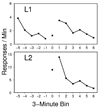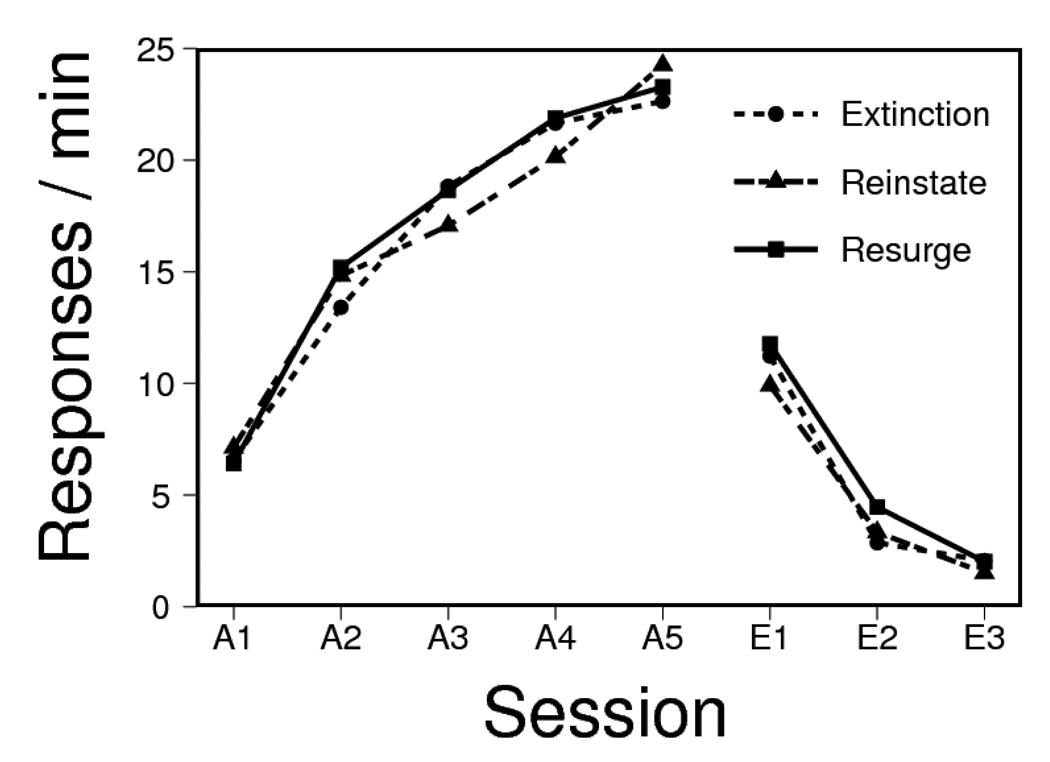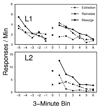Mechanisms of resurgence II: Response-contingent reinforcers can reinstate a second extinguished behavior - PubMed (original) (raw)
Mechanisms of resurgence II: Response-contingent reinforcers can reinstate a second extinguished behavior
Neil E Winterbauer et al. Learn Motiv. 2011.
Abstract
Three experiments with rat subjects examined resurgence of an extinguished instrumental response using the procedure introduced by Epstein (1983) with pigeons. There were three phases: (1) initial acquisition of pressing on a lever (L1) for pellet reward, (2) extinction of L1, and (3) a test session in which a second lever (L2) was inserted, briefly reinforced, and then extinguished. Experiment 1 confirmed that if pressing L2 delivered 20 pellets followed by extinction, rats would resume L1 responding in the final test. Experiment 2 compared the effects of response-contingent and non-contingent rewards delivered upon insertion of L2. Although insertion of L2 alone did not increase L1 responding, response-contingent and non-contingent rewards led to comparable increases in L1 responding. Experiment 3 found that the delivery of non-contingent pellets during extinction of L1, which would be expected to reduce the ability of pellets to set the occasion for the L1 response, also reduced the effects of both response-contingent and non-contingent rewards during the final test. The results indicate that in this method, the resurgence treatment leads to an increase in L1 pressing due to simple presentation of the pellet; delivering the reinforcer after extinction of L1 reinstates L1 responding by setting the occasion for the L1 response.
Figures
Figure 1
Responding on Lever 1 during the sessions of acquisition and extinction in Experiment 1.
Figure 2
Responding on Lever 1 (L1, top) and Lever 2 (L2, bottom) during the test session of Experiment 1. L2 was inserted 15 mins into the session. Lever pressing during the resurgence treatment (0) is at center, and the bin length varies by subject; the remaining data points correspond to the 3-minute bins that preceded (left) and followed (right) the resurgence treatment. Note that L1 and L2 ordinates differ.
Figure 3
Responding on Lever 1 for each group during the sessions of acquisition and extinction in Experiment 2.
Figure 4
Responding on Lever 1 (L1, top) and Lever 2 (L2, bottom) during the test session of Experiment 2. L2 was inserted 15 mins into the session. During treatment (0), Group Resurge was reinforced for the first 20 presses on L2, Group Reinstate received non-contingent pellets (yoked to members of Group Resurge), and Group Ext received no pellets; bin length varied with yoked pairs in Groups Resurge and Reinstate. The remaining data points correspond to the 3-minute bins that followed (right) and preceded (left) the groups’ differential treatment. L1 and L2 ordinates differ.
Figure 5
Responding on Lever 1 during the sessions of acquisition and extinction in Experiment 3. Groups that received no free pellets or free pellets during extinction are each shown in the left and right panels, respectively.
Figure 6
Responding on Lever 1 (L1, top) and Lever 2 (L2, bottom) during the test session of Experiment 3. L2 was inserted 15 mins into the session. During treatment (0), Resurge groups were reinforced for the first 20 presses on L2 and the Reinstate groups received non-contingent pellets (yoked to a member of the corresponding Group Resurge; bin lengths again varied with yoked pairs). The remaining data points correspond to the 3-minute bins that followed (right) and preceded (left) the groups’ differential treatment. L1 and L2 ordinates again differ.
Similar articles
- Effects of thinning the rate at which the alternative behavior is reinforced on resurgence of an extinguished instrumental response.
Winterbauer NE, Bouton ME. Winterbauer NE, et al. J Exp Psychol Anim Behav Process. 2012 Jul;38(3):279-91. doi: 10.1037/a0028853. J Exp Psychol Anim Behav Process. 2012. PMID: 22823421 Free PMC article. - Some Factors Modulating the Strength of Resurgence After Extinction of an Instrumental Behavior.
Winterbauer NE, Lucke S, Bouton ME. Winterbauer NE, et al. Learn Motiv. 2013 Feb 1;44(1):60-71. doi: 10.1016/j.lmot.2012.03.003. Learn Motiv. 2013. PMID: 23515657 Free PMC article. - Resurgence and alternative-reinforcer magnitude.
Craig AR, Browning KO, Nall RW, Marshall CM, Shahan TA. Craig AR, et al. J Exp Anal Behav. 2017 Mar;107(2):218-233. doi: 10.1002/jeab.245. Epub 2017 Feb 14. J Exp Anal Behav. 2017. PMID: 28194793 Free PMC article. - Discriminative properties of the reinforcer can be used to attenuate the renewal of extinguished operant behavior.
Trask S, Bouton ME. Trask S, et al. Learn Behav. 2016 Jun;44(2):151-61. doi: 10.3758/s13420-015-0195-9. Learn Behav. 2016. PMID: 26400498 Free PMC article. - Preventing relapse after incentivized choice treatment: A laboratory model.
Bouton ME, Thrailkill EA, Bergeria CL, Davis DR. Bouton ME, et al. Behav Processes. 2017 Aug;141(Pt 1):11-18. doi: 10.1016/j.beproc.2017.02.005. Epub 2017 Feb 7. Behav Processes. 2017. PMID: 28188809 Free PMC article. Review.
Cited by
- BEHAVIORAL AND NEUROBIOLOGICAL MECHANISMS OF PAVLOVIAN AND INSTRUMENTAL EXTINCTION LEARNING.
Bouton ME, Maren S, McNally GP. Bouton ME, et al. Physiol Rev. 2021 Apr 1;101(2):611-681. doi: 10.1152/physrev.00016.2020. Epub 2020 Sep 24. Physiol Rev. 2021. PMID: 32970967 Free PMC article. Review. - Relapse of operant behavior after response elimination with an extinction or an omission contingency.
Rey CN, Thrailkill EA, Goldberg KL, Bouton ME. Rey CN, et al. J Exp Anal Behav. 2020 Jan;113(1):124-140. doi: 10.1002/jeab.568. Epub 2019 Dec 13. J Exp Anal Behav. 2020. PMID: 31835280 Free PMC article. - Effects of thinning the rate at which the alternative behavior is reinforced on resurgence of an extinguished instrumental response.
Winterbauer NE, Bouton ME. Winterbauer NE, et al. J Exp Psychol Anim Behav Process. 2012 Jul;38(3):279-91. doi: 10.1037/a0028853. J Exp Psychol Anim Behav Process. 2012. PMID: 22823421 Free PMC article. - Context change explains resurgence after the extinction of operant behavior.
Trask S, Schepers ST, Bouton ME. Trask S, et al. Rev Mex Anal Conducta. 2015 Sep;41(2):187-210. Rev Mex Anal Conducta. 2015. PMID: 27429503 Free PMC article. - Resurgence in humans: Reducing relapse by increasing generalization between treatment and testing.
Thrailkill EA, Ameden WC, Bouton ME. Thrailkill EA, et al. J Exp Psychol Anim Learn Cogn. 2019 Jul;45(3):338-349. doi: 10.1037/xan0000209. Epub 2019 Apr 29. J Exp Psychol Anim Learn Cogn. 2019. PMID: 31033312 Free PMC article.
References
- Baker AG, Steinwald H, Bouton ME. Contextual conditioning and reinstatement of extinguished instrumental responding. The Quarterly Journal of Experimental Psychology. 1991;43B:199–218.
- Bouton ME. Context and behavioral processes in extinction. Learning & Memory. 2004;11:485–494. - PubMed
- Bouton ME, Bolles RC. Contextual control of the extinction of conditioned fear. Learning and Motivation. 1979;10:445–466.
- Bouton ME, Rosengard C, Achenbach GG, Peck CA, Brooks DC. Effects of contextual conditioning and unconditional stimulus presentation on performance in appetitive conditioning. The Quarterly Journal of Experimental Psychology. 1993;46B:63–95. - PubMed
LinkOut - more resources
Full Text Sources





